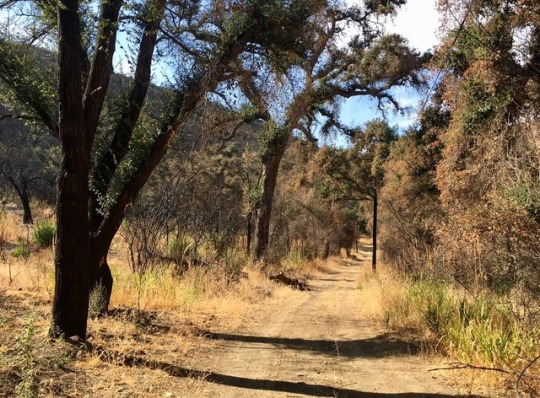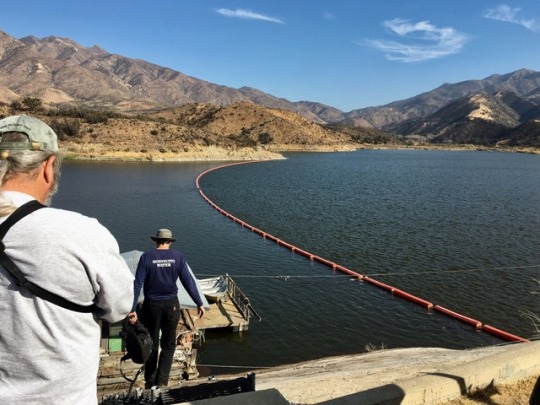lies: I get to go back to Jameson Lake tomorrow. It’s the first time I’ll have been there since…
Sunday, November 18th, 2018lies:
I get to go back to Jameson Lake tomorrow. It’s the first time I’ll have been there since @quickthreebeers and I (and two other birders) were there for the Carpinteria Christmas count last January.
At that time there were still some spots that were smoking from the Thomas Fire. I can’t wait to see how the birds are doing.
Some photos from the day…
Birding at Romero Saddle (the last place you can currently reach by car if you don’t have an in with someone) as we waited for our someone to arrive and lead us through the locked gate. Weird fact: After driving an hour to reach this point I can almost see my house down there.

Down near Alan’s compound at the lake, in a spot where many of the trees survived:

A short distance away, a hillside that didn’t fare so well, but is doing a good job of coming back:

Heading out to check out ducks on the lake:

It was a lot of fun, and it’s definitely coming back. The area where the north fork of Juncal Creek enters the lake, which is just around that point in the photo above where the debris boom reaches the opposite shore, was an eerie, silent expanse of ash in January. But now it’s birdy again, yay! We only had a few minutes there, but got the best bird of the trip in the process.
So, all told: A+ outing would recommend. 🙂👍
Reposted from http://lies.tumblr.com/post/180264220516.
I get to go back to Jameson Lake tomorrow. It’s the first time I’ll have been there since…
Saturday, November 17th, 2018I get to go back to Jameson Lake tomorrow. It’s the first time I’ll have been there since @quickthreebeers and I (and two other birders) were there for the Carpinteria Christmas count last January.
At that time there were still some spots that were smoking from the Thomas Fire. I can’t wait to see how the birds are doing.
Reposted from http://lies.tumblr.com/post/180228917536.
Jameson Lake, Carpinteria Christmas Bird Count, 2018-01-05So, if…
Friday, February 23rd, 2018Jameson Lake, Carpinteria Christmas Bird Count, 2018-01-05
So, if you’ve followed me for a while you know I get really into the bird thing late in the year when the Christmas Count comes around. This past year I got super into it, helping Rob (the founder of our local Christmas Count) organize things, which mostly meant letting him do the hard work of contacting everyone and lining up participants while I did the fun part: scouting (i.e., birdwatching).
We were in the home stretch when a slight hiccup occurred: The Thomas Fire. It burned through the majority of our count circle, forced evacuations of large parts of the Carpinteria Valley, and kept those who stayed behind indoors due to the horrible air quality. We basically had no choice but to postpone the count to Friday, January 5, the last day of the count window.
By the time the rescheduled count rolled around the fire was contained and people were getting their lives back together. The firefighters had done a great job, keeping the fire mostly out of the human-inhabited coastal strip. But inland it had burned unchecked.
We normally work hard to get a team to Jameson Lake, a freshwater reservoir in the northern part of our circle. It’s hard to reach even in the best of times, but it’s worth it; there are birds there we just can’t get on the coast. But this year it was completely inaccessible; no one was being allowed in except firefighters and Forest Service personnel.
Then we got a break: Alan, the dam caretaker at Jameson Lake for the Montecito Water District, is a birder. He’d arranged for us to go in back in November, before the fire, for a scouting visit. Now he’d started going back in for damage assessment, and he scheduled ones of his visits for count day. Even better, he pulled some strings and got permission for a carload of us to go in with him.
So it was that I, along with two other volunteers (Deborah and Taylor, aka @quickthreebeers) got to spend count day out of cellphone range, exploring a burned-out landscape that was eerily silent: no other people, and very few birds.
For the most part it wasn’t great birding. But it was a fascinating look at the aftermath of the fire. And in terms of the citizen-science mission of the Christmas Count, it was a wonderful opportunity to gather data on which birds were there (ducks, woodpeckers, and SO many Dark-eyed Juncoes) and which were gone. I’m really looking forward to going back over the next few years to see the area come back to life.
As I mentioned, we were out of cellphone range all day, so it was only after making the three-hour trip back at the end of the day that I was able to touch base with Rob, and get the good news about the overall count: It went great. We got 155 species, just 3 short of our all-time record.
This is some video I shot of our trip to the lake.
Reposted from http://lies.tumblr.com/post/171217768486.
A few weeks ago the hills above Carpinteria, the coastal town I…
Thursday, January 4th, 2018A few weeks ago the hills above Carpinteria, the coastal town I live in, burned. I was talking to a neighbor today, someone who spent his career working in forest management. He’s retired now, but he’s an expert on wildfire behavior. He’s been volunteering since the fire on restoring the Franklin Trail, which leads from Carpinteria up into the hills. He showed me a map and pointed out the few strips of riparian habitat where the fire damage was relatively light. Except for those isolated pockets, the damage behind Carp is severe. He said he’s never seen a burn pattern like this. In the time leading up to the fire, drought and the persistent high pressure had driven humidity levels so low that when the fire came through the vegetation was like one big expanse of tinder.
The fire crews saved most of the structures. They successfully protected the homes in Ojai, La Conchita, Carpinteria, Montecito, and Santa Barbara. As a result, in tomorrow’s (rescheduled) Carpinteria Christmas Bird Count, most of the accessible areas in the coastal strip where we were planning to bird are actually looking pretty good. Indeed, in the scouting I’ve done since the fire the birding seems better than usual. The unburned areas are filled with displaced chaparral birds; wrentits and California towhees and ruby-crowned kinglets everywhere you look. I think they’re refugees. The carrying capacity of the habitat they’re in won’t have increased. The extra birds will disperse more widely, or will suffer from predation, disease, or starvation. But for now it makes for exciting birding.
That’s the story in the “front country”, the area south of the Santa Ynez crest. The backcountry north of the crest is another matter. There the fires burned largely unchecked. Jameson Lake is seven miles north of Carpinteria. It’s hard to reach even under normal circumstances, requiring a day-long backpacking trip or mountain biking down miles of dirt roads that are closed to private vehicles. We don’t always manage to include it in our Christmas count; it’s great habitat for us, giving us a chance at an inland freshwater lake that we otherwise don’t have, but it’s hard to get there.
This year it’s especially hard. The whole area is closed to the public. The only people with access are fire and forest service crews, and the people who maintain the water facilities at Jameson for the Montecito Water District.
So… tomorrow, thanks to some really nice people pulling some strings on our behalf, we get to go count birds there. I’m going in along with two other birdwatchers, led by the water district employee who lives part-time at the lake (or used to, before his cabin burned down).
I don’t know what we’ll find. I was there on a scouting trip in November. Alan, the caretaker, has been in several times since the fire, and he’s told me not to expect much. Everything has burned. For all I know we’re going to spend all day in a sterile moonscape. But I think it’s important to document what happened. The Christmas counts are mostly for fun, but they also produce useful citizen science. Thousands of volunteers go out each year and catalog the birds they’re able to find. In some count circles above the Arctic Circle they go out in the midwinter twilight to record a single species (thank you, common raven). Next to that I’m getting off easy.
Anyway, that’s what I’ll be doing tomorrow. We’ll see how it goes.
Reposted from http://ift.tt/2qnD9F7.


